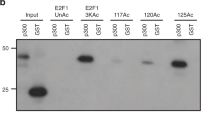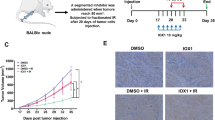Abstract
Epigenetic regulation of chromatin structure is central to the process of DNA repair. A well-characterized epigenetic feature is the dynamic phosphorylation of the histone H2AX (γH2AX) and mobilization of double strand break (DSB) recognition and repair factors to the site. How chromatin structure is altered in response to DNA damage and how such alterations influence DSB repair mechanisms are currently relevant issues. Despite the clear link between histone deacetylases (HDACs) and radiosensitivity, how histone hyperacetylation influence DSB repair remains poorly understood. We have determined the structure of chromatin is a major factor determining radiosensitivity and repair in human cells. Trichostatin A (TSA) enhances radiosensitivity with dose modification factors of 1.2 and 1.9 at 0.2 and 1 μ M, respectively. Cells treated with TSA causing hyperacetylation and remodelling on euchromatic alleles coexist with γH2AX accumulation in radiosensitized cells. Formation of γH2AX on heterochromatin was significantly reduced even when cells were treated with TSA, suggesting that chromatin structure and histone hyperacetylation are pronounced features of radiation sensitivity and repair in euchromatic regions.
This is a preview of subscription content, access via your institution
Access options
Subscribe to this journal
Receive 50 print issues and online access
$259.00 per year
only $5.18 per issue
Buy this article
- Purchase on Springer Link
- Instant access to full article PDF
Prices may be subject to local taxes which are calculated during checkout





Similar content being viewed by others
Accession codes
References
Baylin SB . (2005). DNA methylation and gene silencing in cancer. Nat Clin Pract Oncol 2 (Suppl 1): S4–S11.
Camphausen K, Burgan W, Cerra M, Oswald KA, Trepel JB, Lee MJ et al. (2004a). Enhanced radiation-induced cell killing and prolongation of gammaH2AX foci expression by the histone deacetylase inhibitor MS-275. Cancer Res 64: 316–321.
Camphausen K, Cerna D, Scott T, Sproull M, Burgan WE, Cerra MA et al. (2005). Enhancement of in vitro and in vivo tumor cell radiosensitivity by valproic acid. Int J Cancer 114: 380–386.
Camphausen K, Scott T, Sproull M, Tofilon PJ . (2004b). Enhancement of xenograft tumor radiosensitivity by the histone deacetylase inhibitor MS-275 and correlation with histone hyperacetylation. Clin Cancer Res 10: 6066–6071.
Chinnaiyan P, Vallabhaneni G, Armstrong E, Huang SM, Harari PM . (2005). Modulation of radiation response by histone deacetylase inhibition. Int J Radiat Oncol Biol Phys 62: 223–229.
Chiu SM, Oleinick NL, Friedman LR, Stambrook PJ . (1982). Hypersensitivity of DNA in transcriptionally active chromatin to ionizing radiation. Biochim Biophys Acta 699: 15–21.
Ehrlich M . (2002). DNA methylation in cancer: too much, but also too little. Oncogene 21: 5400–5413.
El-Osta A, Wolffe AP . (2000). DNA methylation and histone deacetylation in the control of gene expression: basic biochemistry to human development and disease. Gene Express 9: 63–75.
Foster ER, Downs JA . (2005). Histone H2A phosphorylation in DNA double-strand break repair. FEBS J 272: 3231–3240.
Harikrishnan KN, Chow MZ, Baker EK, Pal S, Bassal S, Brasacchio D et al. (2005). Brahma links the SWI/SNF chromatin-remodeling complex with MeCP2-dependent transcriptional silencing. Nat Genet 37: 254–264.
Jiang G, Yang F, Sanchez C, Ehrlich M . (2004). Histone modification in constitutive heterochromatin versus unexpressed euchromatin in human cells. J Cell Biochem 93: 286–300.
Jung M, Velena A, Chen B, Petukhov PA, Kozikowski AP, Dritschilo A . (2005). Novel HDAC inhibitors with radiosensitizing properties. Radiat Res 163: 488–493.
Karagiannis TC, Kn H, El-Osta A . (2005). The histone deacetylase inhibitor, trichostatin A, enhances radiation sensitivity and accumulation of gammaH2A.X. Cancer Biol Ther 4: 787–793.
Kass SU, Pruss D, Wolffe AP . (1997). How does DNA methylation repress transcription? Trends Genet 13: 444–449.
Kelly WK, Marks PA . (2005). Drug insight: histone deacetylase inhibitors – development of the new targeted anticancer agent suberoylanilide hydroxamic acid. Nat Clin Pract Oncol 2: 150–157.
Kim MS, Kwon HJ, Lee YM, Baek JH, Jang JE, Lee SW et al. (2001). Histone deacetylases induce angiogenesis by negative regulation of tumor suppressor genes. Nat Med 7: 437–443.
Kladde MP, Xu M, Simpson RT . (1996). Direct study of DNA-protein interactions in repressed and active chromatin in living cells. EMBO J 15: 6290–6300.
Livingstone-Zatchej M, Marcionelli R, Moller K, de Pril R, Thoma F . (2003). Repair of UV lesions in silenced chromatin provides in vivo evidence for a compact chromatin structure. J Biol Chem 278: 37471–37479.
Lyko F, Brown R . (2005). DNA methyltransferase inhibitors and the development of epigenetic cancer therapies. J Natl Cancer Inst 97: 1498–1506.
Marks PA, Dokmanovic M . (2005). Histone deacetylase inhibitors: discovery and development as anticancer agents. Expert Opin Investig Drugs 14: 1497–1511.
Marks PA, Richon VM, Kelly WK, Chiao JH, Miller T . (2004). Histone deacetylase inhibitors: development as cancer therapy. Novartis Found Symp 259: 269–281; discussion 281–288.
Meier A, Livingstone-Zatchej M, Thoma F . (2002). Repair of active and silenced rDNA in yeast: the contributions of photolyase and transcription-couples nucleotide excision repair. J Biol Chem 277: 11845–11852.
Mellon I, Bohr VA, Smith CA, Hanawalt PC . (1986). Preferential DNA repair of an active gene in human cells. Proc Natl Acad Sci USA 83: 8878–8882.
Munshi A, Kurland JF, Nishikawa T, Tanaka T, Hobbs ML, Tucker SL et al. (2005). Histone deacetylase inhibitors radiosensitize human melanoma cells by suppressing DNA repair activity. Clin Cancer Res 11: 4912–4922.
Orphanides G, Reinberg D . (2000). RNA polymerase II elongation through chromatin. Nature 407: 471–475.
Piekarz RL, Robey RW, Zhan Z, Kayastha G, Sayah A, Abdeldaim AH et al. (2004). T-cell lymphoma as a model for the use of histone deacetylase inhibitors in cancer therapy: impact of depsipeptide on molecular markers, therapeutic targets, and mechanisms of resistance. Blood 103: 4636–4643.
Reyes JC, Muchardt C, Yaniv M . (1997). Components of the human SWI/SNF complex are enriched in active chromatin and are associated with the nuclear matrix. J Cell Biol 137: 263–274.
Rogakou EP, Pilch DR, Orr AH, Ivanova VS, Bonner WM . (1998). DNA double-stranded breaks induce histone H2AX phosphorylation on serine 139. J Biol Chem 273: 5858–5868.
Suter B, Livingstone-Zatchej M, Thoma F . (1997). Chromatin structure modulates DNA repair by photolyase in vivo. EMBO J 16: 2150–2160.
Taddei A, Maison C, Roche D, Almouzni G . (2001). Reversible disruption of pericentric heterochromatin and centromere function by inhibiting deacetylases. Nat Cell Biol 3: 114–120.
Taddei A, Roche D, Sibarita JB, Turner BM, Almouzni G . (1999). Duplication and maintenance of heterochromatin domains. J Cell Biol 147: 1153–1166.
Terleth C, Schenk P, Poot R, Brouwer J, van de Putte P . (1990). Differential repair of UV damage in rad mutants of Saccharomyces cerevisiae: a possible function of G2 arrest upon UV irradiation. Mol Cell Biol 10: 4678–4684.
Thoma F . (1999). Light and dark in chromatin repair: repair of UV-induced DNA lesions by photolyase and nucleotide excision repair. EMBO J 18: 6585–6598.
Tsukuda T, Fleming AB, Nickoloff JA, Osley MA . (2005). Chromatin remodelling at a DNA double-strand break site in Saccharomyces cerevisiae. Nature 438: 379–383.
Vidanes GM, Bonilla CY, Toczyski DP . (2005). Complicated tails: histone modifications and the DNA damage response. Cell 121: 973–976.
Xu M, Simpson RT, Kladde MP . (1998). Gal4p-mediated chromatin remodeling depends on binding site position in nucleosomes but does not require DNA replication. Mol Cell Biol 18: 1201–1212.
Zhang Y, Jung M, Dritschilo A, Jung M . (2004). Enhancement of radiation sensitivity of human squamous carcinoma cells by histone deacetylase inhibitors. Radiat Res 161: 667–674.
Zhivotovsky B, Joseph B, Orrenius S . (1999). Tumor radiosensitivity and apoptosis. Exp Cell Res 248: 10–17.
Acknowledgements
We thank Dr Jun Okabe for his suggestions. The support of the Australian Institute of Nuclear Science and Engineering is acknowledged. TCK was the recipient of AINSE awards. Molecular Radiation Biology and Epigenetics in Human Health and Disease Laboratories are supported by the National Health and Medical Research Council of Australia (350359 and 268905). Dr El-Osta acknowledges the Conquer Fragile X Foundation, Lyonel and Joanna Middows Foundation and the Hazel & Pip Appel Charitable Trust.
Author information
Authors and Affiliations
Corresponding author
Rights and permissions
About this article
Cite this article
Karagiannis, T., Kn, H. & El-Osta, A. Disparity of histone deacetylase inhibition on repair of radiation-induced DNA damage on euchromatin and constitutive heterochromatin compartments. Oncogene 26, 3963–3971 (2007). https://doi.org/10.1038/sj.onc.1210174
Received:
Revised:
Accepted:
Published:
Issue Date:
DOI: https://doi.org/10.1038/sj.onc.1210174
Keywords
This article is cited by
-
HJURP is recruited to double-strand break sites and facilitates DNA repair by promoting chromatin reorganization
Oncogene (2024)
-
Knockdown of Rad9A enhanced DNA damage induced by trichostatin A in esophageal cancer cells
Tumor Biology (2016)
-
Bleomycin-induced γH2AX foci map preferentially to replicating domains in CHO9 interphase nuclei
Chromosome Research (2014)
-
Processing of DNA double strand breaks by alternative non-homologous end-joining in hyperacetylated chromatin
Genome Integrity (2012)
-
Enhanced radiosensitivity of EC109 cells by inhibition of HDAC1 expression
Medical Oncology (2012)



